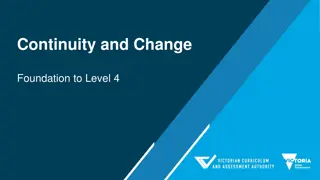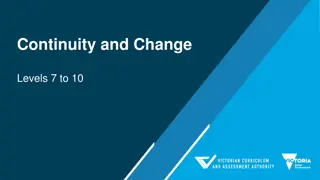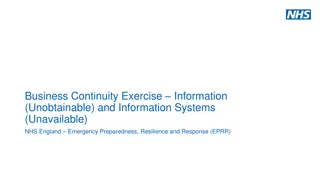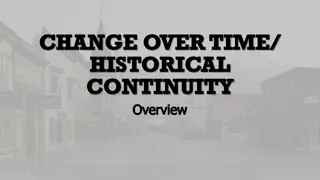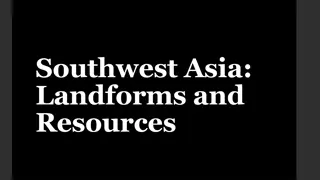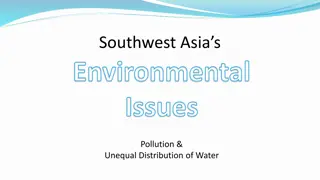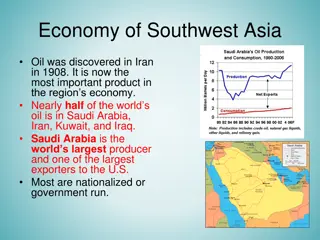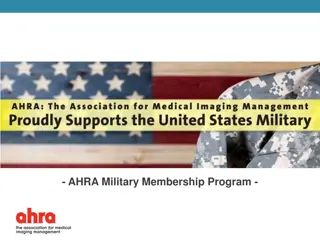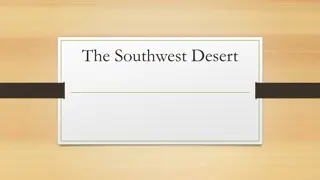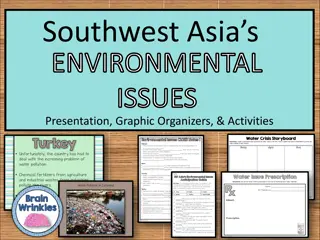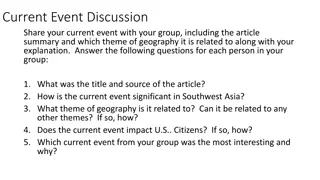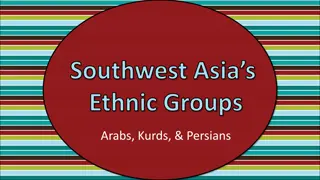U.S. Military Involvement in Southwest Asia: Analyzing Historical Continuity and Change
This unit covers the influence of the U.S. in Southwest Asia and explores events such as the Persian Gulf conflict, invasions of Afghanistan and Iraq. Students will examine the establishment of the modern State of Israel, including historical reasons like Jewish religious ties, the Holocaust, anti-Semitism, and Zionism in Europe. The content delves into Arab reactions to Israel's creation, the Arab-Israeli conflict rooted in religious beliefs, and the Diaspora-Zionism-Anti-Semitism connection with the formation of Israel. Progress reports and study guides are highlighted for upcoming assessments.
Download Presentation

Please find below an Image/Link to download the presentation.
The content on the website is provided AS IS for your information and personal use only. It may not be sold, licensed, or shared on other websites without obtaining consent from the author.If you encounter any issues during the download, it is possible that the publisher has removed the file from their server.
You are allowed to download the files provided on this website for personal or commercial use, subject to the condition that they are used lawfully. All files are the property of their respective owners.
The content on the website is provided AS IS for your information and personal use only. It may not be sold, licensed, or shared on other websites without obtaining consent from the author.
E N D
Presentation Transcript
FSMS 7thGrade Social Studies Unit 2 Change; U. S. Military Involvement September 23-27, 2019 Georgia Standard SS7H2(d)
Standard SS7H2 Southwest Asia (Middle East) leading to the 21stcentury. Standard SS7H2 The student will analyze continuity and change in (d) Explain U.S. presence and interest in Southwest Asia; include the Persian Gulf conflict, invasions of Afghanistan and Iraq.
Agenda Message: SS Monthly Progress Reports go home October 30th. Return signed by parents for a Homework grade of 100! Standard: Explain historical reasons for the establishment of the modern State of Israel in 1948 including Jewish religious connections to the land, the Holocaust, anti-Semitism & Zionism in Europe. E.Q. Monday September 23, 2019: What was the Arab reaction to the creation of the Modern State of Israel? Warm Up: At the root of the Arab-Israeli conflict is a religious belief concern ownership of the land. Explain this belief/conflict. Today We Will: 1. Complete Chapter 25
E.Q. Answer for Monday 9/23/19: Israel's Arab neighbors (Lebanon, Egypt, Jordan, Iraq & Syria) attacked Israel in an attempt to take Arab land back. Warm-Up Answer: Belief that the Patriarch s Abraham, Isaac Jacob were given the land by God. Therefore the land is considered sacred by Jews, Christians and Muslims.
Agenda Message: Quarterly Assessment #1 Study Guides go home Today. Test is October 1st. Standard: Explain historical reasons for the establishment of the modern State of Israel in 1948 including Jewish religious connections to the land, the Holocaust, anti-Semitism & Zionism in Europe. E.Q. Tuesday September 24, 2019: Explain the connection between the Diaspora, Zionism and Anti-Semitism with the creation of the Modern State of Israel. Warm Up: What is the U.S. #1 economic interest in SWA? Today We Will: 1. Complete Chapter 25 2. Start QA #1 Study Guide Revue
E.Q. Answer for Tuesday 9/24/19: The Diaspora was the time in Jewish history where Jews were spread throughout the world and did not have a homeland. The Diaspora led to the Zionism Movement which called for all Jews of the world to be able to return to their original home as it existed in the Bible. Anti- Semitism, the hatred of the Jews further led to the desire for Jews to have their own homeland where Jews would be respected and be safe. Warm-Up Answer: The free flow of oil on the world market.
Agenda Message for Wednesday September 25, 2019: Complete Quarterly Assessment #1 Study Guides. SS Progress Reports go home September 30th. Standard: The U.S. military presence in SWA including the Persian Gulf conflict and invasions of Iraq and Afghanistan. E.Q. for Wednesday 9/25/19: What was the start of the Gulf War in 1990? Warm-Up: Why did so many countries in the United Nations feel persuaded to create the Modern State of Israel in 1948? TODAY WE WILL: 1. SWA Review
E.Q. Answer for Wednesday 9/25/19: Iraq invaded Kuwait in an attempt to take their large oil supplies. The threat to the Persian Gulf s free flow of oil to world markets, including the United States, could not be tolerated. Warm-Up Answer: The world leaders felt tremendous guilt about the suffering of the Jewish people in the holocaust.
U.S Presence and Interest U.S Presence and Interest The United States has had significant political and economic interests in Southwest Asia for over 200 years. Vast supplies of oil are found in this area, oil that is critical to United States energy needs. Since the end of World War I, the United States has played an important role in diplomacy following the break-up of the Ottoman Empire.
U.S Presence and Interest U.S Presence and Interest The U.S. support for the creation of the state of Israel in 1948 also focused attention on this part of the world.
U.S Presence and Interest cont. 1990-1991 Iraq War In August 1990 Iraq invaded Kuwait in an effort to control Kuwait s large oil reserves. U.S Presence and Interest cont. The leader of Iraq, Saddam Hussein, claimed that Kuwait was taking more than they were allowed from shared oil fields. He also claimed that when the Ottoman Empire was partitioned the area that became Kuwait should have been part of Iraq.
U.S Presence and Interest cont. 1990-1991 Iraq War cont. The creation of the country of Iraq in 1920 meant that Iraq no longer had any coastline on the Persian Gulf. U.S Presence and Interest cont. The United States was concerned about the invasion of Kuwait because the United States gets a large portion of its imported oil from Kuwait and Saudi Arabia.
U.S Presence and Interest cont. 1990-1991 Iraq War cont. Kuwait belonged to the United Nations, a world organization that will come to the aid of a member nation that is attacked without cause by another country. U.S Presence and Interest cont. The United Nations voted to raise a military force to liberate Kuwait from the Iraqi invasion.
U.S Presence and Interest cont. 1990-1991 Iraq War cont. Because of the threat to the oil supply, the United States sent troops to be part of this United Nations military force to drive Iraq out of Kuwaiti territory. U.S Presence and Interest cont. This effort was known as the Persian Gulf War Persian Gulf War, or Operation Desert Storm Operation Desert Storm.
U.S Presence and Interest cont. 1990-1991 Iraq War cont. Thirty-nine countries joined in and within three months, by February 1991, the Iraqi government accepted a truce and agreed to withdraw from Kuwait. U.S Presence and Interest cont.
Agenda Message for Thursday September 26, 2019: QA #1 is October 1st. SS Monthly Progress Reports go home Monday. Standard: The U.S. military presence in SWA including the Persian Gulf conflict and invasions of Iraq and Afghanistan. Essential Question for Thursday 9/26/19: Why did the U.S. invade Afghanistan in 2003? Warm-Up: Turkey s building of dams along the Euphrates River has had what effect on its neighbors Syria and Iraq? TODAY WE WILL: 1. History of the Gulf Wars in Iraq & Afghanistan. 2. Practice QA #1
E.Q. Answer for Thursday 9/26/19: Osama bin Laden led the terrorist group, al al- -Qaeda in Afghanistan, which carried out the 9-11 attacks on New York. The U.S. invaded Afghanistan in order to overthrow the Taliban government and to find Osama bin Laden. Qaeda, headquartered Warm-Up Answer: The building of dams along the Euphrates River has meant less water flows to Syria and Iraq causing conflicts with Turkey.
U.S Presence and Interest cont. Afghanistan War Intelligence sources identified an organization known as Al-Qaeda, or the Force, as the group of terrorists that planned and carried out the attack on 9-11. U.S Presence and Interest cont. Its leader was a man who was born in Saudi Arabia named Osama bin-Laden. His family was very wealthy and he used his money to finance this organization.
U.S Presence and Interest cont. Afghanistan War cont. One of the aims of Al-Qaeda is to bring about an end to western influence in the Middle East. U.S Presence and Interest cont. Intelligence sources in the United States government believed that the radical Muslim government of Afghanistan, the Taliban, allowed Al-Qaeda to hide in the mountains of their country.
Agenda Message Friday September 27th: QA #1 is Tuesday! Prepare for Success by STUDYING using your Study Guides & Maps!! Standard: The U.S. military presence in SWA including the Persian Gulf conflict and invasions of Iraq and Afghanistan. E.Q. for Friday 9/27/19: The United States used its military in 2001 in Afghanistan and 2003 in Iraq to establish what type of government in both nations? Warm-Up: Which country invaded Kuwait in August of 1990? TODAY WE WILL 1. Cover the War on Terror, Afghanistan 2. Review for QA #1
E.Q. Answer for Friday 9/27/19: Democracy Warm-Up Answer: Iraq
U.S Presence and Interest cont. Afghanistan War cont. The United States launched a series of attacks on these mountain hideouts in October 2001 in an attempt to capture bin- Laden and destroy his organization. U.S Presence and Interest cont. United States troops were also sent in and the government of the Taliban collapsed.
U.S Presence and Interest cont. Afghanistan War cont. Since 2001, United States troops have continued fighting in Afghanistan in an attempt to find bin-Laden and destroy his organization. U.S Presence and Interest cont. The United States is still working to help the people of Afghanistan reorganize their government to become more of a democracy.
U.S Presence and Interest cont. U.S Presence and Interest cont. Gulf War II In 2003, the United States launched an invasion of Iraq, after claiming that the Iraqi government led by Saddam Hussein, was developing nuclear weapons and offering aid to groups like Al- Qaeda, who were a threat to United States interests in the region. The United States called this military action Operation Iraqi Freedom.
U.S Presence and Interest cont. U.S Presence and Interest cont. Gulf War II The government of Saddam Hussein collapsed quickly because many of the Iraqis also felt he was a cruel leader. However, problems followed as the United States did not have a plan ready to help reorganize and rebuild the country once the old government was gone.
U.S Presence and Interest cont. U.S Presence and Interest cont. Gulf War II American forces have remained in Iraq ever since, trying to stop the fighting between different religious and ethnic groups who are competing with each other for power as they try to organize a new democratic style government.
Summary of Afghanistan & Iraq Wars The United States used its military in 2001 in Afghanistan and 2003 in Iraq to reorganize their governments to be more of a democracy.
The War on Terror The terrorist group, al al- -Qaeda 9/11 (2001) attacks on New York. Osama bin Laden mastermind behind the attacks. Qaeda, carried out the Osama bin Laden led al-Qaeda and was the Al-Qaeda began as a resistance movement against Russia s invasion of Afghanistan during the late 1970 s and early 80 s.
The War on Terror cont. However, once the Russians withdrew, the group turned its focus to advancing a radical form of Islam. Al-Qaeda s interpretation of Islam calls for expelling foreigners from the holy lands. It also seeks to overthrow corrupt countries in Southwest Asia.
The War on Terror cont. To accomplish these goals, al-Qaeda also calls for the destruction of any state it feels supports these corrupt countries. Among the nations it hopes to destroy are Israel and the United States, plus other western European nations.
The War on Terror cont. As a response to 9/11, President Bush declared a U.S. War on Terror War on Terror. Bush stated that the United States would go after foreign terrorists rather than waiting for them to attack us again.
Terrorism in the Middle East Because SWA is filled with so much religious and political history, people there are very passionate about their beliefs. Sometimes people can take these beliefs to harmful extremes.
Terrorism in the Middle East Terrorist groups are extremist people who believe in something so much, they are willing to use violence to achieve their goal. Terrorism is a large problem in Southwest Asia.
Terrorism in the Middle East Here are some of the most dangerous terrorist groups. 1. Al Qaeda (Afghanistan) 2. Al-Jihad (Egypt) 3. Abu Nidal Organization (Iraq) 4. Kach and Kahane Chai (Israel) 5. Hezbollah (Lebanon)
Terrorism in the Middle East Al Qaeda governments all over the world and to get rid of western influences in Muslim countries. Al Qaeda: Its goals are to create Islamic Al Egyptian government and replace it with an Islamic state. Al- -Jihad: Jihad: Its goal is to overthrow the
Terrorism in the Middle East Abu Nidal Organization: a Palestinian state in place of Israel. Abu Nidal Organization: Its goal is to create Kach and Kahane Chai: the Israelite state as described in the Bible. Kach and Kahane Chai: Its goal is to restore Hezbollah: Lebanon to oppose Israel & Middle East peace agreements. Hezbollah: Its goal is to gain power in


